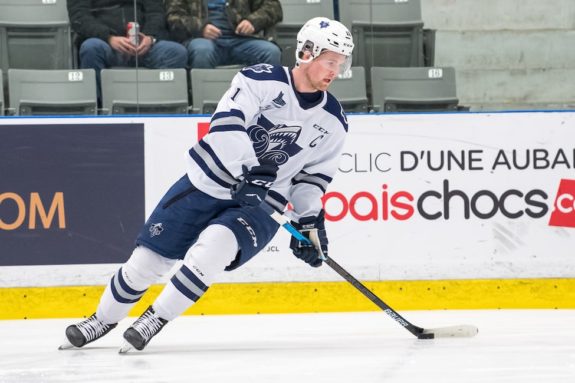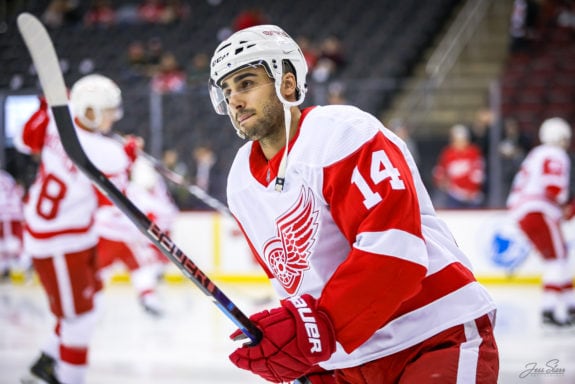On behalf of the Detroit Red Wings, I selected Alexis Lafreniere in The Hockey Writers’ mock draft. To say it was an easy decision would be a gross understatement.
Lafreniere is the consensus top pick in the 2020 NHL Draft. His vision, hockey IQ, and offensive skill set are already elite and he’s expected to be an impact player from the start.
If Detroit does in fact win the Lafreniere sweepstakes, his insertion into the lineup will significantly change next season’s outlook. The Red Wings are due for some good luck, right?
Red Wings Lines With & Without Lafreniere
To illustrate Lafreniere’s potential impact, let’s first take a look at how the 2020-21 lines would shape up with and without him on the team.
First up, let’s assume the Red Wings miss out on the first-overall pick and let their eventual choice spend an extra year developing outside the NHL. Here’s how their lines could look:
| LW | C | RW |
| Anthony Mantha | Dylan Larkin | Tyler Bertuzzi |
| Robby Fabbri | Valtteri Filppula | Filip Zadina |
| Dmytro Timashov | Michael Rasmussen | Darren Helm |
| Frans Nielsen | Luke Glendening | Evgeny Svechnikov |
| Mathias Brome | Christoffer Ehn |
Of course, the fourth line and scratches can shift around. And the Red Wings could also pursue a middle-six free agent in this case. But, generally speaking, this is what can be expected for next season’s team without their lottery pick in the lineup.
Now, let’s take a look at the lines with Lafreniere.
| LW | C | RW |
| Anthony Mantha | Dylan Larkin | Tyler Bertuzzi |
| Alexis Lafreniere | Valtteri Filppula | Filip Zadina |
| Robby Fabbri | Michael Rasmussen | Darren Helm |
| Frans Nielsen | Luke Glendening | Evgeny Svechnikov |
| Dmytro Timashov | Christoffer Ehn |
A bit more scoring punch with Lafreniere, no? Let’s dive into the differences to show just how much of an impact the No. 1-overall selection could provide.
Red Wings’ Second Line
First and foremost, Lafreniere and Filip Zadina could be absolutely dangerous together on the ice. It may take some time to adjust and build chemistry. But by the end of the season, Lafreniere and Zadina could be a dynamic duo slotting in behind the Larkin-Mantha-Bertuzzi line.

In this instance, Lafreniere represents a slight upgrade over Robby Fabbri on the second line alone. Nothing against Fabbri, but Lafreniere is just a cornerstone player with loads of skill. A second line consisting of Fabbri, Zadina, and Valtteri Filppula could produce a fair amount of offense, but just not as much as a line with Lafreniere.
Borrowing an exercise used in a recent Winged Wheel Podcast episode, it’s reasonable to project both Lafreniere and Fabbri scoring about 20 goals as part of the second line over the course of an 82-game season. Even though they’re scoring the same amount here, it’s further down in the lineup where we’ll start to see a difference.
Related: Red Wings’ Best of All-Time: Where Did They Come From?
Red Wings’ Third Line
With Lafreniere skating on the second line, Fabbri gets bumped down to the third alongside Michael Rasmussen and Darren Helm. With his offensive abilities, Fabbri gives this line a scoring touch that it otherwise wouldn’t have. He’s a clear upgrade over Dmytro Timashov (or even Evgeny Svechnikov).

Without Fabbri, the third line has a checking role. There really isn’t much of a difference when compared to Luke Glendening’s fourth line, either.
Essentially, moving Fabbri further down in the lineup gives the Red Wings scoring depth and changes the dynamic of their forward trios. Would you rather have two lines with scoring potential or three?
Using the same goal projection exercise as above, it wouldn’t be a stretch for Fabbri to score 18 goals as part of the third line and on the power play. But with him on the second line, someone like Timashov won’t be able to replicate that goal total. Eight goals is a more likely outcome with Timashov playing on the third line. That 10-goal difference would go a long way, especially for a team that struggled to score this season.
Related: Red Wings Prospect Rankings
Final Word
Inserting Lafreniere into the lineup quickly makes the Red Wings a deeper team. They can reasonably expect to score 10 more goals over the course of the season with him on the roster. And that doesn’t even include residual offensive upgrades that come from moving Timashov down to a fourth line/depth role and bumping down a less talented player to Grand Rapids.
Add in full, healthy campaigns from Zadina, Anthony Mantha, and Danny DeKeyser and Detroit’s goal differential could be much closer to the break-even point than it was this season. Playoffs still might be a pipe dream, but the Red Wings will be much more competitive next year. And that’s exactly what Steve Yzerman is looking for.